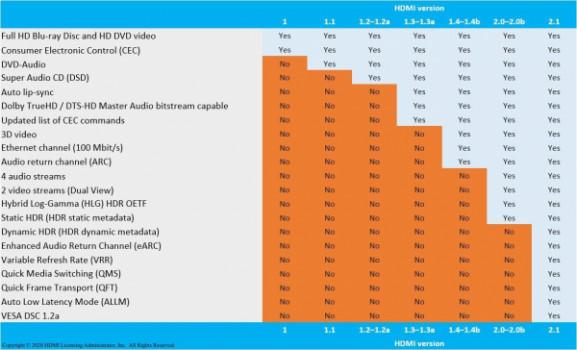
Today I learned unscrupulous marketers have permission to take advantage

Four years running, we’ve been jazzed by the potential of HDMI 2.1 — the relatively new video connector standard that can provide variable refresh rates (VRR), automatic low latency connections (ALLM), and of course, a giant pipe with 48Gbps of bandwidth (and fixed rate signaling) to deliver up to 10K resolution and up to a 120Hz refresh rate depending on your cable and compression.
But today, I’m learning that not only are all of those features technically optional, but that the HDMI standards body owner actually encourages TV and monitor manufacturers that have none of those things — zip, zilch, zero — to effectively lie and call them “HDMI 2.1” anyhow.
That’s the word from TFTCentral, which confronted the HDMI Licensing Administrator with the news that Xiaomi was selling an “HDMI 2.1” monitor that supported no HDMI 2.1 features, and was told this was a perfectly reasonable state of affairs.
It’s infuriating.
It means countless people, some of whom we’ve encouraged in our reviews to seek out HDMI 2.1 products, may get fooled into fake futureproofing if they don’t look at the fine print to see whether features like ALLM, VRR, or even high refresh rates are possible. Worse, they’ll get fooled for no particularly good reason: there was a perfectly good version of HDMI without those features called HDMI 2.0, but the HDMI Licensing Administrator decided to kill off that brand when it introduced the new one.

Very little of this is actually news, I’m seeing — we technically should have known that HDMI 2.1’s marquee features would be optional for a while now, and here at The Kupon4U we’ve seen many a TV ship without full support. In one story about shopping for the best gaming TV for PS5 and Xbox Series X, we characterized it as “early growing pains.”
But now it’s looking like those pains might have just been the start — now that Xiaomi has dipped a toe into murky waters and the HDMI powers-that-be have expressed their support. We confirmed with the HDMI Licensing Administrator that, in fact, Xiaomi is actually doing the right thing as far as it’s concerned. “Devices can no longer be certified for 2.0,” writes HDMI.org spokesperson Douglas Wright.
“We are all dependent on manufacturers and resellers”
“Does HDMI have any comment about the consumer confusion that would likely lead to?” I ask via email. “We are all dependent on manufacturers and resellers correctly stating which features their devices support,” Wright adds.
Do you trust your manufacturer or reseller, who fundamentally try to upsell you as often as they can? Or do you think maybe, say, the standards body should be responsible for making a label that actually means something instead of helping or even pushing companies to mislead you?
“What about USB?” you might ask. Yep, we’ve been similarly annoyed by USB-C branding, where a single cable could theoretically let you charge your laptop, transfer up to 20Gbps of data, hook up multiple monitors and even connect to an external graphics card, but might actually do none of the above. We’ve seen some similar branding shenanigans from USB, too — like when the USB Implementer’s Forum decided to make USB 3.0 and USB 3.1 suddenly look way better at retail by calling them “USB 3.2 Gen 1” and “USB 3.2 Gen 2”.
But usually, I get the feeling that the USB-IF is at least trying to allay consumer confusion with new sets of logos and names, even if it winds up making far too many of them for them to be remotely practical.
As someone who has twice helped family members understand that the number of megapixels has nothing to do with the processing speed of your phone, this sucks. And that’s before we even consider that buying cables for these devices is also a bit of a shitshow, with very little guarantee that you’ll get a quality HDMI or USB-C cable that can actually offer enough bandwidth (and in the case of USB-PD, enough wattage) to power all the features even if your TV, monitor, and laptop offer them.
Please do better, standards bodies.








